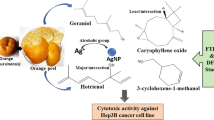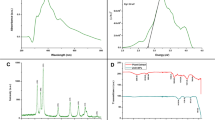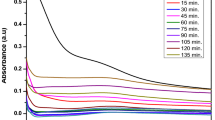Abstract
In this paper, we have established for the first time, the terrific efficiency of aqueous extract of agricultural waste dried peel of sugar apple (Annona squamosa) in the rapid synthesis of stable SnO2 nanoparticles. In topical years, the deployment of secondary metabolites from plant extract has emerged as a novel technology for the synthesis of various nanoparticles. In this paper, we have studied the potential of SnO2 nanoparticles assembly using agricultural waste source for the first time. The synthesized nanoparticles were characterized and confirmed as SnO2 nanoparticles by using UV-visible spectroscopy, XRD, and TEM analysis. The motivation of this study was to examine cytotoxicity study of SnO2 nanoparticles against hepatocellular carcinoma cell line (HepG2). SnO2 nanoparticles inhibited the cell proliferation in a dose- and time-dependent manner with an IC50 value of 148 μg/mL. The treated cells showed an altered morphology with increasing concentrations of SnO2 nanoparticles. Our result shows that the SnO2 nanoparticles exhibit moderate cytotoxicity towards the hepatocellular carcinoma (HepG2) at tested concentrations.






Similar content being viewed by others
References
Madhumitha, G., & Roopan, S.M., (2013). Devasted crops: multifunctional efficacy for the production of nanoparticles. Journal Nanomaterials 2013:1-23. Article ID 951858.
Roopan, S. M., Bharathi, A., Kumar, R., Khanna, V. G., & Prabhakarn, A. (2012). Acaricidal, insecticidal, and larvicidal efficacy of aqueous extract of Annona squamosa L. peel as biomaterial for the reduction of palladium salts into nanoparticles. Colloids Surf B- Biointerfaces, 92, 209–212.
Roopan, S. M., Surendra, T. V., Elango, G., & Kumar, S. H. S. (2014). Biosynthetic trends and future aspects of bimetallic nanoparticles and its medicinal applications. Appl Microbiol Biotechnol, 98, 5289–5300.
Kumar, R., Roopan, S. M., Prabhakarn, A., Khanna, V. G., & Chakroborty, S. (2012). Agricultural waste Annona squamosa peel extract: biosynthesis of silver nanoparticles. Spectrochim Acta B At Spectrosc, 90, 173–176.
Kumar, S., Mandal, P. R., Selvakannan, R., Parischa, A. B., Mandale, M., & Sastry. (2003). Investigation into the interaction between surface-bound alkylamines and gold nanoparticles. Langmuir, 19, 6277–6282.
Chandrasekharan, N., & Kamat, P. V. (2000). Improving the photo electrochemical performance of nanostructured TiO2 films by adsorption of gold nanoparticles. J Phys Chem B, 104, 10851–10857.
Peto, G., Molnar, G. L., Paszti, Z., Geszti, O., Beck, A., & Guczi, L. (2002). Electronic structure of gold nanoparticles deposited on SiOx/Si. Mater Scie Eng, 19, 95–99.
Bose, A. C., Thangadurai, P., & Ramasamy, S. (2006). Grain size dependent electrical studies on nanocrystalline SnO2. Mater Chem Phys, 95, 72–78.
Epifani, M., Comini, E., Diaz, R., Arbiol, J., Sciciliano, P., Sberveglieri, G., et al. (2006). Oxide nanopowders from the low-temperature processing of metal oxide sols and their application as gas-sensing materials. Sensors Act B-Chem, 118, 105–109.
Williams, G., & Coles, G. S. V. (1999). The gas-sensing potential of nanocrystalline tin dioxide produced by a laser ablation technique. MRS Bull, 24, 25–29.
Fujihara, S., Maeda, T., Ohgi, H., Hosono, E., Imai, H., & Kim, S. H. (2004). Hydrothermal routes to prepare nanocrystalline mesoporous SnO2 having high thermal stability. Langmuir, 20, 6476–6481.
Zhang, D., Qi, L., Ma, J., & Cheng, H. (2002). Synthesis of sub micrometer-sized hollow silver spheres in mixed polymer-surfactant solutions. Adv Mater, 14, 1499–1502.
Tan, O. K., Cao, W., Hu, Y., & Zhu, W. (2004). Nano structured oxide semiconductor materials for gas-sensing applications. Ceram Int, 30, 1127–1133.
Baraton, M. I., & Merhari, L. (2004). Nanoparticles-based chemical gas sensors for outdoor air quality monotoring micro stations. Mater Sci Eng B, 112, 206–213.
Roopan, S. M., & Khan, F. R. N. (2010). ZnO nanoparticles in the synthesis of AB ring core of camptothecin. Chem Pap, 64, 812–817.
Roopan, S. M., & Khan, F. R. N. (2011). SnO2 nanoparticles mediated nontraditional synthesis of biologically active 9-chloro-6, 13-dihydro-7-phenyl-5H-indolo [3,2-c]-acridine derivatives. Med Chem Res, 20, 732–737.
Roopan, S. M., & Khan, F. R. N. (2010). ZnO nanorods catalyzed N-alkylation of piperidin-4 one, 4(3H)-pyrimidone, and ethyl 6-chloro-1,2-dihydro-2-oxo-4-phenyl quinoline-3-carboxylate. Chem Pap, 64, 678–682.
Hemalatha, K., Madhumitha, G., Kajbafvala, A., Anupama, N., Sompalle, R., & Roopan, S.M., (2013). Function of nanocatalyst in chemistry of organic compounds revolution: an overview. Journal of Nanomaterial 2013:1-23. Article ID 341015.
Bharathi, A., Roopan, S. M., Kajbafvala, A., Padmaja, R. D., Darsana, M. S., & Kumari, G. N. (2014). Catalytic activity of TiO2 nanoparticles in the synthesis of some 2,3-disubstituted dihydroquinazolin-4(1H)-ones. Chin Chem Lett, 25, 324–326.
Roopan, S. M., Bharathi, A., Prabhakarn, A., Rahuman, A. A., Velayutham, K., Rajakumar, G., et al. (2012). Efficient phyto-synthesis and structural characterization of rutile TiO2 nanoparticles using Annona squamosa peel extract. Spectrochim Acta Part B-Atomic Spectrosc, 98, 86–90.
Mosmann, T. (1983). Rapid colorimetric assay for cellular growth and survival: application to proliferation and cytotoxicity assays. J Immunol Methods, 65, 55–63.
Madhumitha, G., Rajakumar, G., Roopan, S. M., Rahuman, A. A., Priya, K. M., Saral, A. M., et al. (2012). Acaricidal, insecticidal, and larvicidal efficacy of fruit peel aqueous extract of Annona Squamosa and its compounds against blood-feeding parasites. Parasitol Res, 111, 2189–2199.
Satishkumar, G., Titelman, L., & Landau, M. V. (2009). Mechanism for the formation of tin oxide nanoparticles and nanowires inside the mesopores of SBA-15. J Solid State Chem, 182, 2822–2828.
Acknowledgments
We thank the management of VIT University for providing all the facilities to carry out this work. We acknowledge the support extended by VIT-SIF for the spectral analysis. Also, Dr. S.M. Roopan thanks DBT for providing DBT-RGYI project (No. BT/PR6891/GBT/27/491/2012) fund.
Author information
Authors and Affiliations
Corresponding author
Rights and permissions
About this article
Cite this article
Roopan, S.M., Kumar, S.H.S., Madhumitha, G. et al. Biogenic-Production of SnO2 Nanoparticles and Its Cytotoxic Effect Against Hepatocellular Carcinoma Cell Line (HepG2). Appl Biochem Biotechnol 175, 1567–1575 (2015). https://doi.org/10.1007/s12010-014-1381-5
Received:
Accepted:
Published:
Issue Date:
DOI: https://doi.org/10.1007/s12010-014-1381-5




